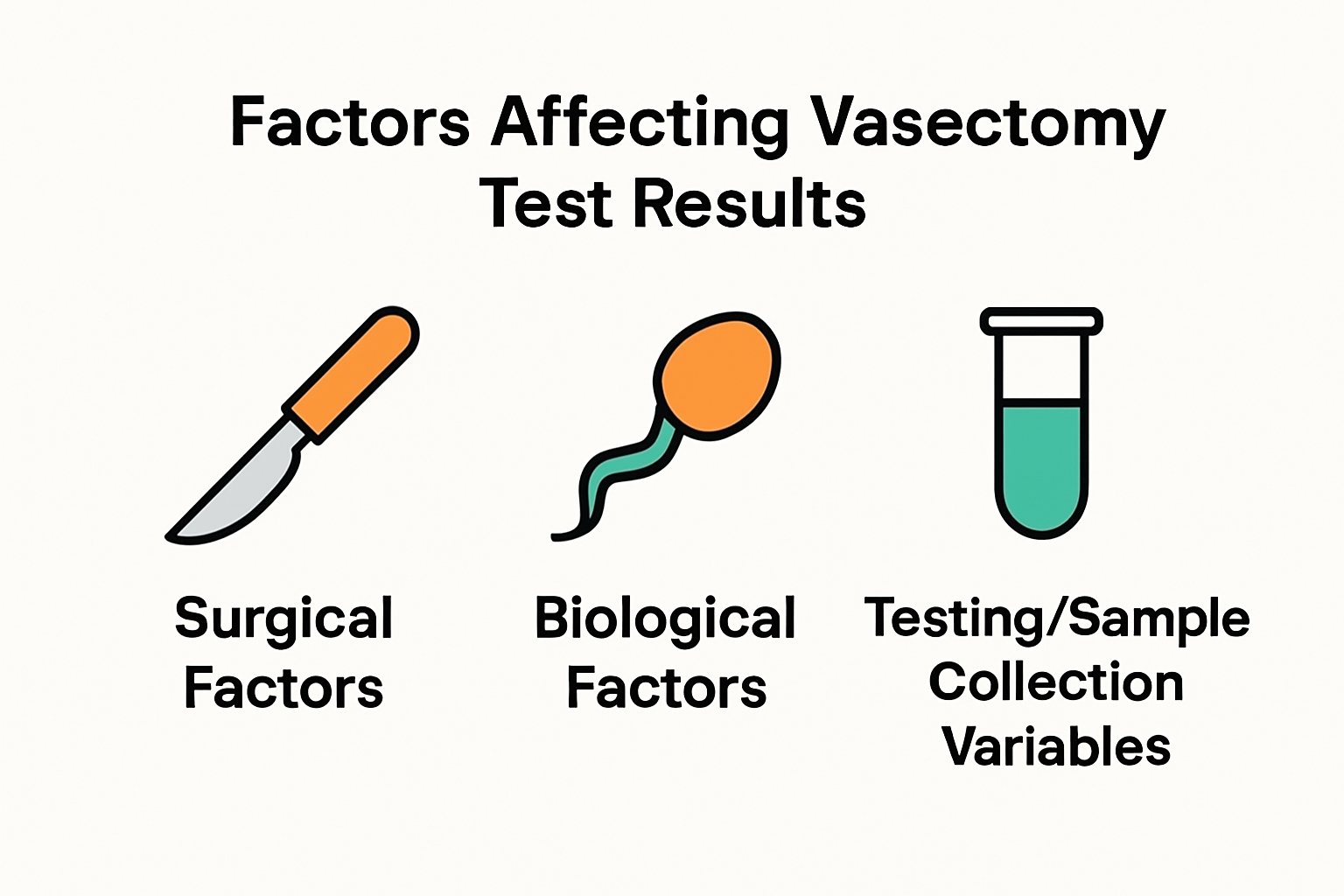Getting a vasectomy is a big decision, but interpreting the results afterwards can be even more nerve-wracking. Here is something surprising. Having zero sperm in your first follow-up test is actually pretty rare, and about 1 to 2 percent of vasectomies require a repeat procedure or extra intervention. Many men see some sperm show up on their early tests, but that does not mean failure. What actually matters most is whether motile sperm are present several months after your procedure. The unexpected part is that patience and a series of follow-up tests are the real keys to confirming your vasectomy worked, not just a single zero on your first lab report.
Table of Contents
- What Your Vasectomy Test Results Mean
- Understanding Sperm Count Numbers
- Factors That Can Affect Results
- When To Follow Up With Your Doctor
Quick Summary
| Takeaway | Explanation |
|---|---|
| Zero or Near-Zero Sperm is Ideal | A successful vasectomy is indicated by a semen analysis showing zero or very few sperm (less than 100,000 non-motile sperm/mL). |
| Follow-Up Semen Analyses are Crucial | Multiple semen analyses should be conducted post-vasectomy, with the first occurring 8-12 weeks after the procedure to ensure sterility. |
| Interpreting Motility and Concentration Matters | Both sperm concentration and motility need to be considered; the presence of motile sperm may indicate a need for further medical intervention. |
| Consult Your Doctor for Abnormal Results | Immediate medical consultation is essential if you experience persistent symptoms or abnormal test results, as these may suggest complications. |
| Be Patient Through the Process | Achieving confirmed sterility can take time, and patience is required to undergo follow-up testing and interpretation of results with your healthcare provider. |
What Your Vasectomy Test Results Mean
Understanding your vasectomy test results is crucial for confirming the success of your procedure and ensuring your contraceptive reliability. The primary method for verifying a successful vasectomy is through a comprehensive semen analysis that examines sperm count and motility.
Reading Your Semen Analysis Report
A post-vasectomy semen analysis is the gold standard for determining whether the procedure has effectively prevented pregnancy. The report will focus on two critical aspects: sperm count and sperm motility. A successful vasectomy means zero or near-zero sperm presence in your semen sample.
Typically, you will receive results classified into three primary categories:
- Negative Result: Zero sperm detected (ideal outcome)
- Low Sperm Count: Minimal sperm present
- Abnormal Result: Significant sperm presence indicating procedure failure
According to American Urological Association guidelines, a truly successful vasectomy requires less than 100,000 non-motile sperm per milliliter of semen. If motile sperm are detected at six months post-procedure, the vasectomy is considered unsuccessful, and additional intervention might be necessary.
Understanding Potential Result Scenarios
Navigating your test results requires understanding the nuanced interpretations. Most men will undergo multiple semen analyses to confirm sterility. The first test typically occurs around 8-12 weeks post-vasectomy, with follow-up tests recommended to ensure consistent results.
If your initial test shows any sperm presence, do not panic. This is relatively common and does not automatically mean failure. Your urologist will likely recommend:
- Repeat semen analysis in 4-6 weeks
- Continued use of alternative contraception
- Potential additional medical review
Research from the National Institutes of Health indicates that approximately 1-2% of vasectomies require a repeat procedure or additional intervention to achieve complete sterility. This underscores the importance of thorough follow-up testing and careful interpretation of your results.
Key considerations when interpreting your results include tracking sperm count trends, understanding the difference between non-motile and motile sperm, and maintaining open communication with your healthcare provider. Your specific medical history, surgical technique, and individual healing process will influence result interpretation.
Remember that while test results provide critical information, they are not instantaneous. The body requires time to clear existing sperm and fully seal the vas deferens. Continued contraception is recommended until your healthcare provider confirms complete sterility through multiple negative test results.
Understanding Sperm Count Numbers
Sperm count numbers can seem complex and intimidating, but understanding these metrics is crucial for confirming the success of your vasectomy. These numerical results provide critical insights into your reproductive status and help determine whether you have achieved complete sterility.
Decoding Sperm Concentration Thresholds
In post-vasectomy semen analysis, sperm count is measured in concentration per milliliter of semen. According to clinical guidelines, the key thresholds are precise and medically significant:
- Below 100,000 non-motile sperm/ml: Very low risk result
- Any motile sperm present: Potential vasectomy failure
- Zero sperm: Ideal outcome indicating successful procedure
Research from the American Urological Association highlights that the probability of pregnancy risk varies dramatically with sperm concentration. At lower concentrations, the risk is minimal, but it increases significantly at higher levels.
Interpreting Motility and Concentration
Motility refers to sperm movement, which is as critical as concentration in determining vasectomy success. A successful vasectomy should result in:
- Zero or near-zero sperm count
- No motile (moving) sperm
- Consistent results across multiple tests
Your medical professional will consider both concentration and motility when interpreting results. A result showing low concentration but active sperm movement might still indicate a need for further intervention.
It is essential to understand that sperm count can fluctuate. Urology experts recommend multiple tests over several months to confirm complete sterility. Your first test might show some sperm presence, which does not automatically mean failure. Follow-up analyses will provide a more comprehensive picture of your reproductive status.
Patients should maintain open communication with their healthcare provider, carefully review all test results, and continue using alternative contraception until definitively cleared. The journey to confirmed sterility requires patience, multiple tests, and a thorough understanding of these numerical indicators.
Factors That Can Affect Results
Vasectomy test results are not always straightforward. Multiple factors can influence the accuracy and interpretation of your semen analysis, making it crucial to understand the potential variables that might impact your results.
Surgical Technique and Procedural Factors
The specific method used during your vasectomy can significantly affect test outcomes. Research from urological experts indicates that vasectomies performed with mucosal cautery and fascial interposition demonstrate higher reliability in test results. These advanced techniques provide more consistent occlusion of the vas deferens, reducing the chance of unexpected sperm presence.
Key surgical factors that can influence results include:
- Precision of vas deferens cutting
- Method of sealing the surgical site
- Surgeon’s experience and technique
- Individual anatomical variations
Biological and Personal Health Considerations
Your individual biological characteristics play a significant role in test result interpretation. Medical research suggests several personal health factors can impact vasectomy effectiveness and test results:
- Age and overall reproductive health
- Pre-existing medical conditions
- Healing and recovery process
- Potential underlying genetic variations
Some men experience slower sperm clearance due to unique physiological characteristics. This means your body might take longer to completely clear existing sperm from the reproductive tract, potentially affecting initial test results.
Testing and Sample Collection Variables
The process of collecting and analyzing semen samples introduces additional variables that can impact result accuracy. Urology specialists recommend considering these potential influencing factors:
- Time since vasectomy procedure
- Proper sample collection technique
- Laboratory analysis methods
- Potential contamination during collection
- Individual variation in sperm production and clearance
It is crucial to follow your healthcare provider’s specific instructions for sample collection. Improper collection can lead to misleading results that may require repeat testing. Factors such as sexual activity before sample collection, incorrect storage, or delayed submission can all potentially compromise test accuracy.  Professional medical guidance is essential in navigating these complex factors. Your urologist will consider your unique medical history, surgical details, and individual biological characteristics when interpreting test results. Multiple follow-up tests provide the most comprehensive understanding of your vasectomy’s effectiveness.
Professional medical guidance is essential in navigating these complex factors. Your urologist will consider your unique medical history, surgical details, and individual biological characteristics when interpreting test results. Multiple follow-up tests provide the most comprehensive understanding of your vasectomy’s effectiveness.
Remember that while these factors can seem overwhelming, modern medical techniques and thorough follow-up protocols ensure high accuracy in determining vasectomy success. Open communication with your healthcare provider and adherence to recommended testing protocols will help you confidently interpret your results.
When to Follow Up With Your Doctor
Navigation through post-vasectomy care requires strategic communication and timely follow-up with your healthcare provider. Understanding when and how to engage with your doctor ensures comprehensive monitoring of your reproductive health and vasectomy effectiveness.
Recommended Follow-Up Timeline
The post-vasectomy follow-up process is structured and systematic. Clinical guidelines recommend a specific timeline for patient monitoring:
- First semen analysis: 8-12 weeks post-procedure
- Second analysis: 4-6 months after vasectomy
- Final clearance: Typically around 6 months post-surgery
Only your clinician can officially confirm vasectomy success. Do not assume sterility without professional medical verification. Each follow-up appointment allows your doctor to assess healing, review test results, and address any potential complications.
Critical Scenarios Requiring Immediate Doctor Consultation
Certain situations demand prompt medical attention beyond the standard follow-up schedule. Urological experts suggest immediate doctor consultation if you experience:
- Persistent pain or discomfort lasting more than a few weeks
- Unusual swelling or bruising
- Fever or signs of infection
- Unexpected changes in testicular sensation
- Abnormal semen analysis results showing sperm presence
These scenarios might indicate potential surgical complications or incomplete vas deferens occlusion requiring professional assessment.
Interpreting and Confirming Results
Your doctor plays a crucial role in definitively interpreting semen analysis results. Medical research emphasizes that patient self-interpretation can lead to misunderstandings. Professional medical guidance ensures:
- Accurate result interpretation
- Understanding potential variability in test outcomes
- Determining when additional testing is necessary
- Providing official clearance for contraceptive reliability
Maintain open communication with your healthcare provider. Ask questions about your specific results, understand the nuances of your individual case, and follow their recommended protocol for confirming vasectomy success.
Remember that achieving confirmed sterility is a process. Patience, multiple tests, and professional medical oversight are key to ensuring the effectiveness of your vasectomy. Your doctor is your primary partner in navigating this important reproductive health milestone.
Frequently Asked Questions
What do my vasectomy test results mean?
A vasectomy test result is primarily concerned with sperm count and motility. A successful outcome is indicated by a negative result, showing zero or near-zero sperm present in your semen sample.
How long after a vasectomy should I wait for my first semen analysis?
You should have your first semen analysis approximately 8-12 weeks after your vasectomy to confirm sterility. Multiple tests will follow to ensure consistent results.
What should I do if my semen analysis shows sperm presence post-vasectomy?
If sperm is detected on your semen analysis, do not panic. It’s common to see some sperm early on. Your doctor will likely recommend a repeat test in 4-6 weeks and continued use of alternative contraception until confirmed sterile.
When should I contact my doctor after my vasectomy?
You should contact your doctor if you experience persistent pain, unusual swelling, fever, or if your semen analysis shows unexpected results like sperm presence. These may signal complications requiring immediate attention.





